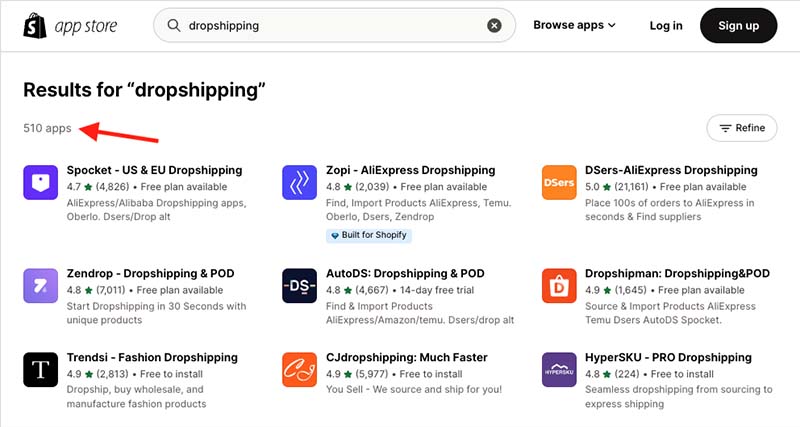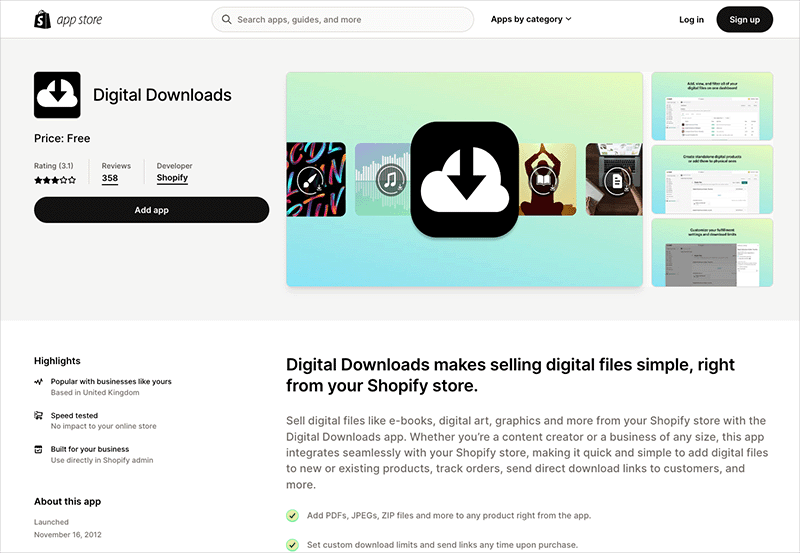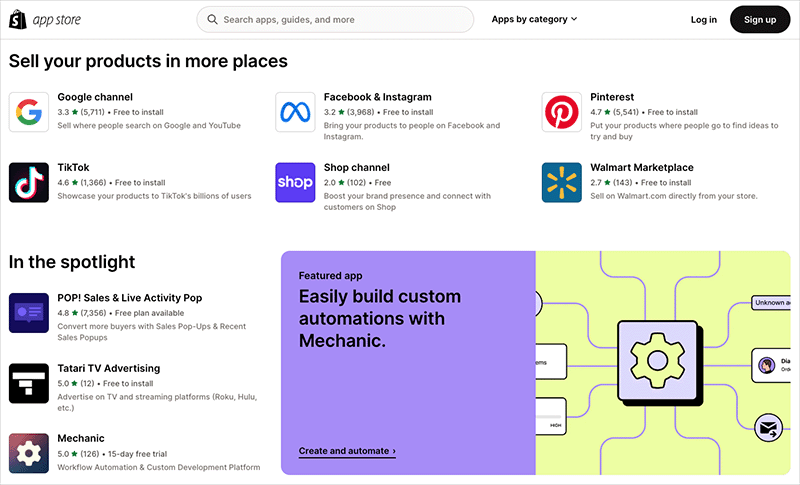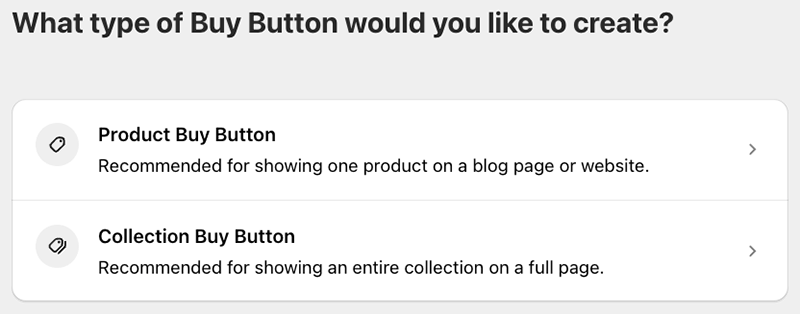
In this post we give you 25 super Shopify side hustle ideas. Read on to discover ways that you can use this popular ecommerce platform to start an online store that generates a significant income — and discover a bunch of business ideas that you may not have thought of before.
1. Start a dropshipping business
Dropshipping is a way of selling online where you don’t buy, make or ship the products you list on your online store. Instead, you take orders for them and pass them onto a supplier (AliExpress, Spocket, etc.) who then fulfils your order.
The main advantage of dropshipping is that it’s a low-risk way to start a business — you don’t need much in the way of capital to start doing it.
When you dropship, you simply become a ‘middle man,’ marking up other people’s products; and if your store is a success, it can prove to be a reliable source of passive income.

To dropship effectively with Shopify, you’ll need to identify products that are in high demand and have a good profit margin. You should also choose suppliers that are reliable, ethical and have a good track record of fulfilling orders quickly.
2. Sell print-on-demand products
Print-on-demand services (like Printful or Printify) give you an easy way to create unique t-shirts, mugs, tote bags, phone cases and many other products without the need for inventory management or production costs.

You simply upload your designs to your chosen service and specify what products you’d like them printed on; you’re then given access to mockups of products that you can sell on your own online store.
When a visitor to your store orders one, your chosen print-on-demand service will handle all the rest — manufacture, shipping, returns etc.
📚 Related print-on-deman resources:
3. Sell digital products
Selling digital products like ebooks, music, photos, online courses, printable resources or software can help you build a very profitable business. This is mainly because once you’ve created your digital product, there are no manufacturing or production costs to worry about again.
Although it’s usually a good idea to ensure that the production values of a digital product are strong, even very lo-fi digital products can prove immensely popular and generate a lot of revenue for a store.
You can sell digital goods easily on Shopify using its free ‘Digital Downloads’ app (pictured below), but if this isn’t sophisticated enough for your needs, a wide range of other digital download apps is available from the Shopify app store.

Don’t miss out — download our free Shopify Startup Kit
Our free Shopify Startup Kit is a must for anyone thinking of building an online store with Shopify. Containing a comprehensive e-book on starting a Shopify store, video tutorials, PDF cheatsheets and much more, it’s packed full of practical advice on how to get a Shopify business off the ground. It’s available for free to Style Factory readers — but for a limited time only.
4. Sell niche products
Shopify is a platform that a lot of people turn to in order to start selling physical items. And it’s very good for doing this.
However, the Internet is packed full of stores selling every product under the sun, so in order to have the best chance of succeeding in this competitive market it makes a lot of sense to focus heavily on niche products — items that may not have the biggest audience, but in which there is keen interest.
Examples of these include products relating to very specific interests or hobbies; handmade goods; a clothing line in a very specific fashion style; and antiques.

If your niche products can command premium prices, and you can attract the right audience to your store, you can end up with a particularly profitable Shopify side hustle.
💡Tip: to find a profitable niche for your store, make sure you learn how to do keyword research properly! The video below shows you how to do this.
5. Sell subscription boxes
Selling subscription boxes can be a great way to make money with Shopify. You curate a selection of products to send to subscribers on a regular basis — and generate a recurring revenue stream in the process.

It’s important to note that you don’t have to make these products yourself — you can collaborate with small businesses and artisans to create custom products that are only available in your subscription box.
Food, drinks and coffee beans tend to work well as products to include in a Shopify subscription box service.
📚 Related resource: 30 things you can sell on a Shopify store
6. Sell educational products

Selling educational products or services can be a profitable Shopify side hustle. You can use the platform to offer online courses, ebooks, or tutoring services that help people learn new skills or improve their knowledge.
💡 Tip: this side hustle works best when you can offer accreditation as part of your offering.
7. Sell personalized products

Selling made-to-order, personalized items can be a great Shopify side hustle, because these types of products are more unique in nature — and stand out from generic goods.
You could for example offer wedding gifts that feature the names of the happy couple; engraved jewellery; or customizations made to items that a visitor to your store already owns.
The only thing to note here is that selling in this way will usually involve adding a third-party app to your Shopify store — the platform doesn’t provide a tool for doing this easily out of the box. Lots of these are available in the Shopify app store, however.
💡Tip: the popular print-on-demand service Printful can help you sell customized products really easily on Shopify. Learn more about this tool in our full Printful review.
8. Sell your skills

If you have a skill, you can sell it on Shopify. Whether you’re an event planner, a business coach, a therapist, a motivational speaker or a gardener, you can make yourself available for hire easily using the platform.
💡 Tip: Shopify is currently testing a new offer that lets you extend your trial to three months for $1/mo. This offer is likely to be available for a limited time only, however.
9. Provide web design or development services to Shopify store owners

If you have web design or development skills, you can offer these as a service to Shopify store owners. Simple customizations of themes and more advanced coding work can command high prices.
💡 Tip: you can gain customers for Shopify web development services by promoting them on the Shopify Experts website.
10. Create and sell Shopify apps

A huge number of stores have been built with Shopify — over 5.5 million in fact — and their owners are always on the look out for apps that can enhance them in various ways.
So, if you have coding skills, a good way of putting them to use is via app development for the platform.
📚 Related resource: Best Shopify apps for beginners
11. Provide Shopify consulting services
If you’ve built a lot of stores from scratch with Shopify in the past, you could consider offering consulting services to businesses looking to create one.
Useful Shopify consulting services include assistance with store setup, content creation, design, and marketing.
💡 Tip: you can deliver consulting services easily to Shopify store owners via video calls (and note that paid-for webinars to multiple store owners can increase the profitability of this approach).
12. Offer Shopify store maintenance
So long as you’re very familiar with the Shopify platform (including its technical aspects), you can offer website maintenance services for Shopify stores.
These can include product updates, backups, and security checks.
13. Provide shipping and fulfillment services

You can provide shipping and fulfillment services to Shopify store owners who need help with order processing and shipping logistics.
To succeed with a shipping and fulfillment side hustle, it’s important to have strong organizational and time-management skills, and you’ll also need a good understanding of shipping carriers and rates.
14. Offer digital marketing services

An online store only becomes successful when a lot of people know about its existence — and digital marketing is usually key to generating this awareness.
Accordingly, there’s a lot of potential revenue in the provision of online marketing services to Shopify store owners — these can include creating and managing social media accounts; content creation; and running PPC ad campaigns.
15. Provide search engine optimization (SEO) services

So long as you’ve got the relevant skills, you can generate a lot of revenue by offering Shopify SEO services.
These can include keyword research, on-page optimization, content production, local SEO and link building.
16. Provide customer support for Shopify merchants

Building a store and shipping goods is only one part of running a Shopify business — fielding customer queries and handling returns and exchanges is a huge part of the process too.
Time-stretched merchants are often in need of a partner to provide this customer support to their customers — and, for a fee, you could be that partner.
17. Provide product photography or videography services
Product photos and videos are a crucial component of a successful Shopify store — and not every merchant has the right skills to produce these professionally themselves.
You can step in here by offering a service that creates beautiful product photos and videos for a Shopify catalog, or shooting lifestyle and branding content that brings a store to life.

18. Offer virtual assistant services
When a Shopify-based business grows, it generates a lot of admin work that its owner can struggle to deal with. Why not offer virtual assistant (VA) services to Shopify store owners who need help with this?
You could for example charge a fee to complete key Shopify admin tasks like managing customer emails, scheduling appointments, and organizing files.
So long as you’re suitably qualified, you could also offer accountancy and bookkeeping services to Shopify store owners.
19. Offer translation services

Shopify provides a lot of multilingual and multi-currency features; a lot of its users are taking advantage of these and selling their products internationally.
You can profit from this increase in global selling by offering translation services for Shopify store owners who need help with presenting their web content and product descriptions in different languages.
20. Offer content writing services
Behind a lot of successful online stores you’ll often find great content that attracts visitors and customers.
But not every Shopify merchant is a great writer, and there’s a big market for talented writers who can create blog posts that really draw people in. If that sounds like you, there may be a profitable side hustle available to you as a content writer or producer.

21. Offer influencer marketing services
You can offer influencer marketing services for Shopify store owners. If you’re an influencer yourself, you can use your platform to highlight and promote merchants’ products.
If not, identifying and collaborating with influencers to promote items for sale on Shopify stores might also prove to be a viable side hustle.
22. Provide inventory management services

As a Shopify-based business grows, inventory becomes a larger and larger headache for Shopify store owners — tracking and storing stock can get very complex, quite quickly.
You can ease these merchants’ pain by providing inventory management services for Shopify store owners. Such services typically involve warehousing, tracking inventory, forecasting demand and managing supplier relationships.
23. Flip Shopify stores
If you’ve got the budget and business skills to do so, you could consider ‘flipping’ Shopify stores. This involves buying a Shopify store, making it more profitable, and selling it at a higher price than you bought it for.
The video below — where we interview Greg Elfrink of the website selling business Empire Flippers — contains a really detailed overview of how to go about selling a Shopify store successfully.
24. Take your existing brick and mortar store online
If you run an existing ‘brick and mortar’ store — i.e., one that sells products in a physical location (like a retail outlet or a market stall) — you can use Shopify to take it online.
You’ll already have a product line and stock — so it should be a simple case of using Shopify to create a virtual version of your existing business.
You may find that using Shopify’s point-of-sale features you’ll actually be able to enhance the operations of your physical business in the process; Shopify’s POS system lets you accept payments in physical locations and syncs inventory data with your online store so that your stock levels remain accurate.
You can learn more about Shopify point of sale here.
25. Monetize an existing blog
If you have a blog that generates a lot of traffic, Shopify can provide you with a great way to monetize it. Using its ‘Buy Button’ feature, you can embed products easily into your existing posts — your readers can then simply click an ‘add to cart’ button to buy a product that is relevant to what they’re reading about.

Alternatively, you could use a Shopify app to paywall content on your store (the Locksmith app is a popular solution for doing that).
And that’s that — 25 ideas on how to create a successful Shopify side hustle! Good luck with starting your new business and if you have any questions about Shopify, do leave them in the comments section below. We read them all and will do our best to help.
📚 Related resource: ecommerce business ideas.


No comments